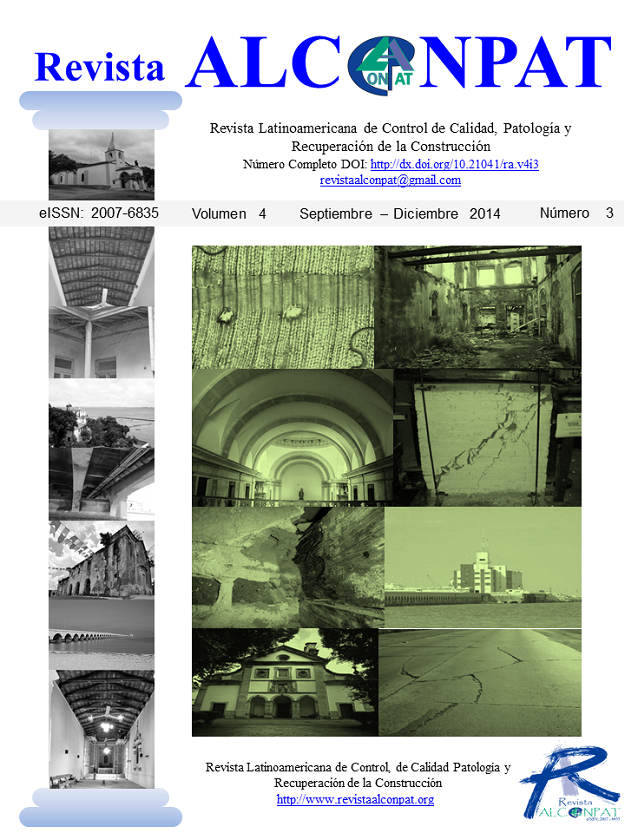Análise da origem das manifestações patológicas em pavimento de concreto de uma rodovia pelo método dos elementos finitos: estudo de caso
DOI:
https://doi.org/10.21041/ra.v4i3.67Keywords:
Pathology, Pavements, ConcreteAbstract
Regarding issues pertaining to infrastructure, it is observed that the Brazilian’s highway
Mário Quintana, call ERS-118, located in the state of Rio Grande do Sul , Brazil , announces
in alarming conservations circumstances and trafficability due to the high deterioration
degree of the pavement . The objective of this work is to analyze the possible causes that
produced the pathological manifestations in the pavement concrete. The study was based on
the structural analysis of these elements. Therefore, this study was based on the method of
finite elements and subsequent analysis of the results produced by the correlation between
stress versus number of permissible axle bushings. The study was divided into three parts: (1)
method of pavement’s structural analysis, (2) discussion of the results and (3) conclusion. As
a result, it was found that many of the pathological manifestations may have stemmed from
the thermal effects arising in the pavement concrete.
Keywords: Pathology. Pavements. Concrete
Downloads
References
Ashtakala, B.; Poorooshasb; H.B (1989). “Prediction of tensile cracks in road pavements”. In: Mathematical and Computer Modeling. Volume 12, Issue 1, p. 55–60. DOI: https://doi.org/10.1016/0895-7177(89)90445-7
Balbo J. T. (1989), “Aplicação do método dos elementos finitos na avaliação estrutural de pavimentos rígidos rodoviários”. Dissertação de mestrado. Universidade de São Paulo, São Paulo, Brasil.
Balbo J. T. (1996), “Practical considerations for concrete pavement design based on numerical model”. In: 1er Congresso Interamericano de Pavimentos Rigidos, Buenos Aires: Argentina.
Balbo J. T. (2009), “Pavimentos de Concreto”. São Paulo, Brasil.
Bialas, M.; Mróz, Z. (2006). “Crack patterns in thin layers under temperature loading Part II: Cyclic loading”. In: Engineering Fracture Mechanics. Volume 73, Issue 7. p. 939-952. DOI: https://doi.org/10.1016/j.engfracmech.2005.10.013
Colim, G.; Balbo, J.T.; Khazanovich, L (2011). “Effects of temperature changes on load transfer in plain concrete pavement joints”. In: Revista IBRACON Estruturas e Materiais, V.4, p. 405-437. DOI: https://doi.org/10.1590/S1983-41952011000300005
Colley, B.E.; Humphrey, H.A (1966). “Entrosagem de Agregados em Juntas de Pavimentação de Concreto de Cimento Portland”. In: 2º Simpósio sobre Pesquisas Rodoviárias. Rio de Janeiro.
DNIT IPR-714 (2005) Manual de Pavimentos Rígidos. Rio de Janeiro, Brasil.
Helene, P. (2007), “Rehabilitación y Mantenimento das Estructuras de Concreto”. São Paulo, Brasil.
Medina, J.; Motta, L. M. G. (2005). “Mecânica dos pavimentos”. Rio de Janeiro: Brasil.
NBR 6118 (2014), “Projeto de estruturas de concreto – Procedimento. Associação Brasileira de Normas Técnicas – ABNT”. Rio de Janeiro, Brasil.
Oliveira, H.; Correia, P.L (2009). “Automatic road crack segmentation using entopy and image dynamics theresholding”. Proc. European Signal Processing Conference, Glasgow, Scotland.
Schindler, A. K.; McCullough, B.F (2002). “The Importance of Concrete Temperature Control During Concrete Pavement Construction in Hot Weather Conditions”. University of Texas at Austin. Washington. DOI: https://doi.org/10.3141/1813-01
Senço, W. (1997), “Manual de Técnicas de Pavimentação”. São Paulo, Brasil.
Severi, A. A. (2002), “Estudo dos gradientes térmicos em pavimentos de concreto de cimento Portland no ambiente tropical”. Tese de doutorado. Universidade de São Paulo, São Paulo, Brasil.
Downloads
Published
How to Cite
Issue
Section
License
_______________________________
License in effect from September 2020
You are free to:
- Share — copy and redistribute the material in any medium or format for any purpose, even commercially.
- Adapt — remix, transform, and build upon the material for any purpose, even commercially.
- The licensor cannot revoke these freedoms as long as you follow the license terms.
Under the following terms:
- Attribution — You must give appropriate credit , provide a link to the license, and indicate if changes were made . You may do so in any reasonable manner, but not in any way that suggests the licensor endorses you or your use.
- No additional restrictions — You may not apply legal terms or technological measures that legally restrict others from doing anything the license permits.
Notices:
You do not have to comply with the license for elements of the material in the public domain or where your use is permitted by an applicable exception or limitation .
No warranties are given. The license may not give you all of the permissions necessary for your intended use. For example, other rights such as publicity, privacy, or moral rights may limit how you use the material.





















.png)














